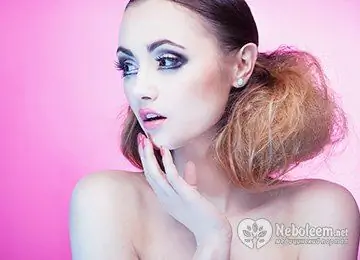- Author Rachel Wainwright [email protected].
- Public 2023-12-15 07:39.
- Last modified 2025-11-02 20:14.
Ombre hair coloring

Two-tone hair coloring with a horizontal blurred line is called the ombre style. This word, translated from French, means shadow, so this method is often called shading. Ombre hair coloring is a smooth or abrupt transition from dark roots to light ends, which mimics the effect of sun-bleached hair, which has become widespread in recent years.
Ombre hair coloring technique
Fashionable ombre hair dyeing has a number of advantages, thanks to which this technique has received great recognition of the fair sex all over the world. Among the main advantages of the method are:
- Maximum naturalness of color;
- Visual volume, which is achieved due to the play of color on such hair;
- Can be used on hair of any length and type;
- No need for regular visits to the hairdresser and colorist, since the hair, growing back, does not look neglected;
- Minimal damage to hair, since the dye is applied only to individual strands, while the hair roots remain natural.
The ombre hair coloring technique consists of several methods. The first one looks like this. Hair is divided into 5-6 equal horizontal strands and bouffant is done on each of them. Then paint is applied to the strands from the earlobe to the tips and wrapped in foil for 25-30 minutes. If you have bangs, you can also dye the ends. The result is a stylish look.
The second method of the ombre hair coloring technique provides a sliding transition from one shade to another. First, the hair is combed well, then, starting from the top, paint is applied in separate strands with smooth movements. If the roots are not sufficiently regrown, you should initially paint them in a dark shade, only then move on to the second color.
And finally, the third method of ombre hair dyeing technique involves carrying out the procedure at home. For this, a special brush is used, which is usually sold with ombre paint. There is a recess between the teeth of this brush where you need to squeeze out the paint. You should be aware that if the brush is drawn along the hair horizontally, the effect will be sharper, and if vertically, the transition will be smooth.
It is important to note that it is recommended to do fashionable ombre hair coloring in a special salon with an experienced master, since it is difficult to independently determine the uniformity and intensity of color transitions.
Ombre dyeing for dark hair
Ombre coloring on dark hair allows you to show your maximum imagination and create an original look. This is due to the fact that in this case, both contrasting colors and a smooth transition of a dark shade to a lighter shade are suitable. The result looks very beautiful if you choose chestnut, light brown, light brown or copper color for painting.
It is believed that the lighter tone should start approximately from the earlobe, but this is not a mandatory rule for dyeing ombre on dark hair. First of all, the choice of the starting place for coloring depends on the length of the hair and personal preference. On long hair of a dark color, options often look great when a light shade starts slightly above the earlobe.
The sharp contrast of colors when dyeing ombre on dark hair is more suitable for owners of straight hair or those who tend to straighten it often. It should be noted that the number of shades does not have to be limited to two: you can experiment and get several color transitions. A clearly defined horizontal hairline in this case gives the image extravagance and originality.
Ombre dyeing for blonde hair
The easiest way to dye ombre for blonde hair is to tint the ends in a lighter color. To do this, choose a paint that will be several tones lighter than the natural hair color in order to get the desired effect.
For lovers of extravagant solutions with light hair, it is recommended to create a bright image using contrasting shades. In this case, rich copper or bluish-black colors are perfect for fashionable ombre hair dyeing. Again, you can go beyond two shades and choose several colors for light hair.
Ombre for short hair
As noted above, the ombre technique is suitable for all hair types and lengths. And a short haircut is no exception to this method. Therefore, dyeing ombre for short hair also has its advantages. First of all, it is airiness, splendor and additional volume of the hairstyle.
In addition, you can achieve a very original look by creating an asymmetrical outline at the ends when dyeing ombre on short hair. The outline can start with a bang and blend into a brighter color. This solution will suit lovers of the classic style of this technique.

A vivid image can be obtained by highlighting individual strands and dyeing the ends of the hair with a sharp transition to a natural shade. In this case, the horizontal line will be clearly expressed, which looks very original on a short haircut.
As for the hairstyle, ombre hair coloring should be done in accordance with it. For example, the smooth transition of natural shades is very suitable for curly long hair with a cascading haircut. In this case, dark chestnut natural tones look perfect, turning into a lighter wheat, light brown or caramel shade. This transition is also recommended for owners of large curls.
As for the sharp transition of contrasting colors when dyeing hair with ombre, it is more suitable for straight hair or short hair. This is due to the fact that the effect in this case consists precisely in a pronounced horizontal line, which separates the shades.
Found a mistake in the text? Select it and press Ctrl + Enter.






